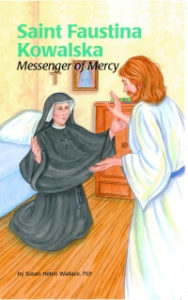God’s face is the face of a merciful father who is always patient. Have you thought about God’s patience, the patience He has with each one of us? That is His mercy. He always has patience with us, He understands us, He waits for us, He does not tire of forgiving us if we are able to return to Him with a contrite heart.
Pope Francis
Leaders! Please leave your craft/snack/game suggestions and links in the comment section below!
St. Faustina Quiz
(All questions are based on information given in the biography in your Little Flower Member’s Guide except for the Bonus Question. Answers are at the bottom of the page.)

a. 1915-1980
b. 404-445
c. 1673-1708
d. 1905-1938
2. Where did St. Faustina live?
a. Poland
b. France
c. The United States
d. Argentina
3. What religious order did St. Faustina enter?
a. Sisters of the Divine Mercy
b. Congregation of the Sisters of Our Lady of Mercy
c. Salesian Sisters
d. Order of the Immaculate Heart of Mary
4. What message did God give to St. Faustina?
a. The message of his Sacred Heart
b. The message of His Divine Mercy
c. The message of Our Lady’s Immaculate Conception
d. The message of the importance of fasting
Bonus: What was St. Faustina’s name before she became a nun?
a. Maria
b. Helen
c. Irena
d. Grace
Quiz Answers: q :snuoq ,q4 ,q3 ,ɐ2 ,p1
Lily Facts
- According to legend lilies appeared when Our Lady was assumed into heaven.
- Some types of lilies can grow six feet high.
- Certain types of lilies can be eaten and are used as an herbal medicine.
Flower Meaning
The lily is a springtime flower and traditionally represents new life and new beginnings and is associated with Easter. At Easter we remember God’s mercy in a special way as we celebrate the salvation that Jesus’ death and resurrection give us. This gift of salvation gives a new life and a new beginning as children of God.
Although our actions are small and ordinary in themselves, because of love they become great and powerful before God.
St. Faustina
Back to Wreath II
Next
Below are some supplemental resources we recommend for your personal use or for use in your club. Click the images to be redirected.




Wreath 2, St Faustina -a Snack inspired by Devine Mercy Painting/Image
3 layer ombré Clear (Royal Brand Frozen Jello, sold at Walmart), pink and red. Spoon decorated with white, pink & red ribbon. From Leader: Bethany via Facebook.
In the Little Flowers Member’s Guide for Wreath II, one of the suggested activities is to look up the definition of Mercy and discuss how to apply it in everyday life. In this activity, the group will be able to work together to truly understand what Mercy is and have the chance to come up with their own definition.
To play, you will have to do some prep beforehand. First, find as many dictionaries as you can, including Bible dictionaries, Catholic dictionaries, non-Catholic Christian dictionaries, secular dictionaries, and online dictionaries. You can do this by visiting your nearest library, or just searching online. Here’s a few to get you started:
Merriam-Webster
Dictionary.com
BibleStudyTools.com
TheFreeDictionary.com
Wikipedia
Now, in all of these dictionaries, look up and write down the definition they give for Mercy. Each definition should be written on its own index card. Only use the most relevant one that can closely resemble the virtue (i.e. don’t use “often said as an exclamation in times of stress.”)
At the meeting, give each girl a definition and have them read it aloud to the whole group. If there are parts of it they don’t understand, talk it through with them. Help everyone get a sense of what mercy means and how it can be applied as a virtue.
Next, have all the girls turn their index cards over to the blank side and write, in their own words, what mercy means. Have everyone trade index cards with the person next to them, and read the definitions again.
You’ll be surprised at how well they’re able to understand the virtue once they’ve had the chance to put it in their own words. Finish the activity by talking about how you can apply this new understanding in everyday life.
Original blog post here: https://www.beholdpublications.com/BeholdChristBlog/wp-admin/post.php?post=1072&action=edit
Correction, original post here: https://www.beholdpublications.com/BeholdChristBlog/2014/09/27/define-mercy/